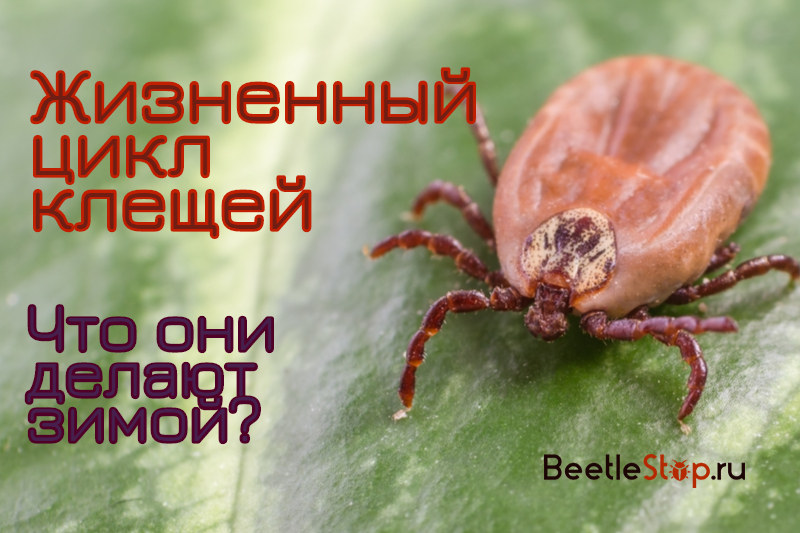What do ticks do in winter?
With the onset of frost, insects hide in secluded places until spring. Ticks, although they belong to the family of arachnids, also seek refuge from snow and freezing temperatures. Parasites live from 2 to 8 years, so they have to wait out the cold at various stages of development. Ticks in winter arrive in a passive state, but can be activated at any time with an increase in temperature.

Tick Life Cycle
Ticks belong to the class of arachnids, their body consists of two parts - the head and body. Small parasites have 6 pairs of limbs; the anterior ones are modified into claw-shaped appendages. The remaining limbs are used for movement, each leg consists of 6 segments, ending in claws and suction cups, allowing to stay on the owner.
Among the many species, danger to humans and animals is ixodid ticks. They are carriers of viral diseases - tick-borne encephalitis and borreliosis. Adult individuals are divided into two sexes - the male is small (2-2.5 mm), its back is covered with chitinous shell, the female reaches 3-4 mm, it is covered by a shield by a third. After drinking blood, the parasite increases several times. After mating, the female lays up to 17 thousand eggs.
Arthropod development involves several phases:
- egg;
- larva;
- nymph;
- adult (female or male).
Attention. Blood-sucking parasites go to the next stage of development after feeding. In the process of a bite, the virus encephalitis or another disease enters the bloodstream.
Winter diapause
The fact that the time of parasite activity falls on May - June is known to many, but are there ticks in winter? The onset of cold weather makes them seek refuge and freeze until spring. A favorable environment for bloodsucking are warm and humid places. They settle in ravines, tall grass, often forests. They do not tolerate hot, dry air, so activity in the summer decreases. With the onset of frost, parasites hide in the upper layer of soil, under the leaves, clog under the bark.
Information. It is difficult for small arachnids to winter in coniferous forests, where there is no thick leaf cover on the ground.
Manifestations of diapause
In the cold season, ticks are significantly inhibited by life processes. The decrease in metabolism allows them to survive without consequences the low temperature and lack of nutrition. The parasite freezes at that stage of development, which was in the fall. Most larvae, having not found a host before the frost, will not become nymphs until next year. Only in regions with a hot climate the life cycle of ticks is 1 year.
Where do ticks hibernate? Their favorite wintering place is under the cover of leaves and grass, where the temperature does not drop to negative levels. The thicker the forest carpet, the more bloodsucking parasites survive and wait for the warm April days. With the onset of a steady temperature above +30 on the first thaw, ticks come to life. The activity of individuals depends on weather conditions and terrain. General warming increases the season in which parasites are dangerous to humans and animals. Sucking individuals are removed from dogs in October-November.
Interesting fact. In snowy winters, about 20-25% of wintering parasites die. Ticks left hungry for the cold survive harsh conditions better than individuals that drank blood before hibernation.A hungry individual can arrive in a state of diapause up to 3 years.
In early autumn, females, after drinking blood, crawl into the thickness of the deciduous litter for laying eggs. This process, depending on temperature, begins in 2-3 weeks. The amount of clutch depends on the amount of blood drunk. Eggs can remain until spring or from them small larvae manage to appear. They stay in winter in the foliage where they were born. The activity of parasites will manifest in the spring with the advent of rodents - field voles, forest mice.

Winter bite cases
The attack of blood-sucking parasites in winter is an exception to the rule. This situation is possible if the tick enters the house in the fall, and when the temperature rises, it shows activity after a few months.
Attention. In the case of an abnormally warm winter, ticks wake up and can attack animals or people. For residents of the village, the source of danger is hay harvested for the winter; parasites can hide in it.
The life cycle of arachnids from egg to egg laying is at least 3 years. In difficult weather conditions, it lengthens up to 5-6 years. This is due to the fading of life processes in the winter. In frosts, molting of larvae, laying of eggs, and nutrition that promotes conversion to an adult are stopped. Winter is a time when you can not be afraid of the bites of bloodsucking parasites.


 (votes: 13, average rating: 4,00 out of 5)
(votes: 13, average rating: 4,00 out of 5)
Yeah, tell about the diapause to 9 ticks taken from the dog after a walk in the field at -5. Campaign time to update scientific data. And all were more than viable
Below could be +1.